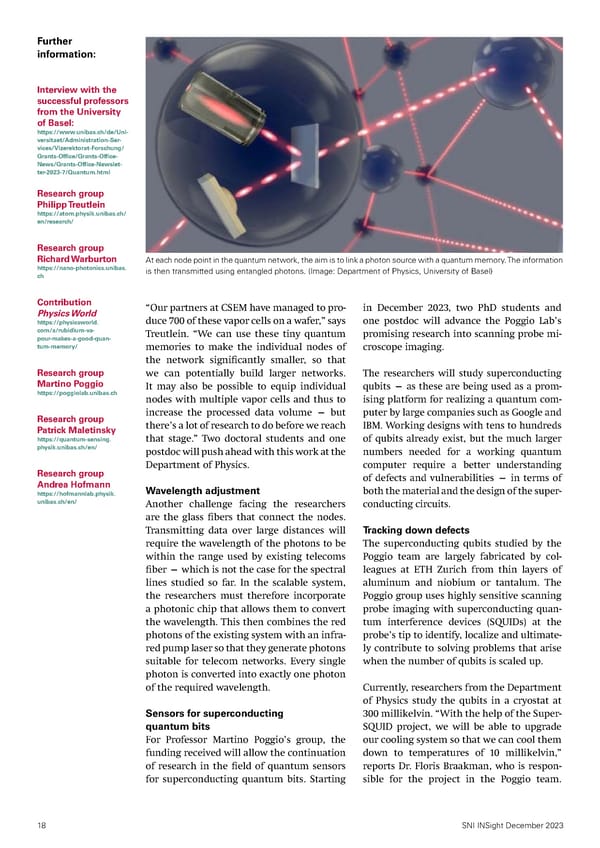Further information: Interview with the successful professors from the University of Basel: https://www.unibas.ch/de/Uni- versitaet/Administration-Ser- vices/Vizerektorat-Forschung/ Grants-Office/Grants-Office- News/Grants-Office-Newslet- ter-2023-7/Quantum.html Research group Philipp Treutlein https://atom.physik.unibas.ch/ en/research/ Research group Richard Warburton At each node point in the quantum network, the aim is to link a photon source with a quantum memory. The information https://nano-photonics.unibas. is then transmitted using entangled photons. (Image: Department of Physics, University of Basel) ch Contribution “Our partners at CSEM have managed to pro- in December 2023, two PhD students and Physics World duce 700 of these vapor cells on a wafer,” says one postdoc will advance the Poggio Lab’s https://physicsworld. com/a/rubidium-va- Treutlein. “We can use these tiny quantum promising research into scanning probe mi- pour-makes-a-good-quan- tum-memory/ memories to make the individual nodes of croscope imaging. the network signi昀椀cantly smaller, so that Research group we can potentially build larger networks. The researchers will study superconducting Martino Poggio It may also be possible to equip individual qubits — as these are being used as a prom- https://poggiolab.unibas.ch nodes with multiple vapor cells and thus to ising platform for realizing a quantum com- Research group increase the processed data volume — but puter by large companies such as Google and Patrick Maletinsky there’s a lot of research to do before we reach IBM. Working designs with tens to hundreds https://quantum-sensing. that stage.” Two doctoral students and one of qubits already exist, but the much larger physik.unibas.ch/en/ postdoc will push ahead with this work at the numbers needed for a working quantum Department of Physics. computer require a better understanding Research group of defects and vulnerabilities — in terms of Andrea Hofmann Wavelength adjustment both the material and the design of the super- https://hofmannlab.physik. unibas.ch/en/ Another challenge facing the researchers conducting circuits. are the glass 昀椀bers that connect the nodes. Transmitting data over large distances will Tracking down defects require the wavelength of the photons to be The superconducting qubits studied by the within the range used by existing telecoms Poggio team are largely fabricated by col- 昀椀ber — which is not the case for the spectral leagues at ETH Zurich from thin layers of lines studied so far. In the scalable system, aluminum and niobium or tantalum. The the researchers must therefore incorporate Poggio group uses highly sensitive scanning a photonic chip that allows them to convert probe imaging with superconducting quan- the wavelength. This then combines the red tum interference devices (SQUIDs) at the photons of the existing system with an infra- probe’s tip to identify, localize and ultimate- red pump laser so that they generate photons ly contribute to solving problems that arise suitable for telecom networks. Every single when the number of qubits is scaled up. photon is converted into exactly one photon of the required wavelength. Currently, researchers from the Department of Physics study the qubits in a cryostat at Sensors for superconducting 300 millikelvin. “With the help of the Super- quantum bits SQUID project, we will be able to upgrade For Professor Martino Poggio’s group, the our cooling system so that we can cool them funding received will allow the continuation down to temperatures of 10 millikelvin,” of research in the 昀椀eld of quantum sensors reports Dr. Floris Braakman, who is respon- for superconducting quantum bits. Starting sible for the project in the Poggio team. 18 SNI INSight December 2023
 SNI INSight December 2023 Page 17 Page 19
SNI INSight December 2023 Page 17 Page 19